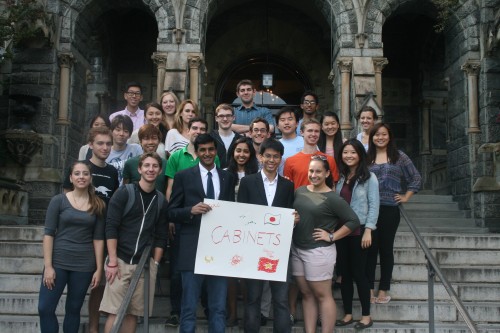This article is part of the NAIMUN Featured Series in preparation for NAIMUN 50, and was written by Pavan Rajgopal, Undersecretary General for Cabinets, and VP Dao, Deputy Undersecretary General for Cabinets
From the halls of the Kremlin to the jungles of Colombia, from the Imperial Palace in Tokyo to make-shift government headquarters in Hanoi, from the banks of the Suez Canal to the streets of Madrid, the Cabinets of NAIMUN 50 offer a wide range of crisis scenarios and committee dynamics for the most “battle-hardened” of model UN delegates.
The last, but surely not least, of the organs featured in the series, Cabinets has long held a reputation for its intensity, creativity, and dynamism. The smallest of the five NAIMUN organs, with the average committee size of fewer than eighteen delegates, Cabinets takes pride in its fast-paced, crisis-centered, and delegate-focused committees. The chairs and directors in the committee room, as well as the crisis managers and analysts in the crisis suite, all strive to create an engaging and educational individual experience for each delegate while also working for a cohesive, fun, and dynamic experience for each committee as a whole.
This February, NAIMUN 50 will feature six Cabinets committees. Spanish Civil War, a joint crisis committee, will simulate the struggle for the fate of Spain between Franco’s Nationalists and the Republican leadership. Members of Japanese Cabinet, 1894 will face the task of steering a fledging empire through dangerous waters, against fierce competition from Russia, China, and various European powers. In FARC Leadership, 2014, delegates will be forced to choose between a return to radicalism and a transition towards democratic participation for one the declining but persistent insurgent group.
Meanwhile, in Democratic Republic of Vietnam Government, 1946, delegates will find themselves challenged with the delicate management of foreign relations, tricky maneuvers in domestic politics, and complex preparation for potential war. Those attending Soviet Politburo, 1989 will navigate political upheavals across the crumbling communist bloc, making hard decisions about whether and how to reform the stagnant and unpopular Soviet system. And the members of Egyptian Cabinet, 1956 will find themselves in the middle of an international crisis in the wake of the nationalization of the Suez Canal and will be responsible for charting a course out of dangerous waters for the land of pharaohs.
Each of these committees offers a unique set of challenges for delegates. All of them, however, present high school students with tasks that often confound even the hardiest of political and military leaders in real life. Decisions of war and peace; reform and retrenchment; brinksmanship and cooperation rest on the shoulders of teenagers. The goal of the Cabinets staff, though, is not to overwhelm the delegates. Rather, in planning the various crisis scenarios for the four days of the conference, members of the dais and the crisis staff seek to impress upon delegates the monumental difficulties of leadership and governance and hope to provide them with the opportunity to hone their skills in negotiation, deliberation, and problem-solving.
As “crunch-time” for NAIMUN approaches, the thirty-eight members of the Cabinets staff are busy “conspiring” the last details of the many crisis plans for their respective committees. Like in all other years, staffers come from all four classes at Georgetown with varying levels of MUN experience and diverse backgrounds. Each staffer, from the Undersecretary General and Deputy Undersecretary General to the directors and crisis analysts, is committed to providing their delegates with an unrivaled and unforgettable Model UN experience.



